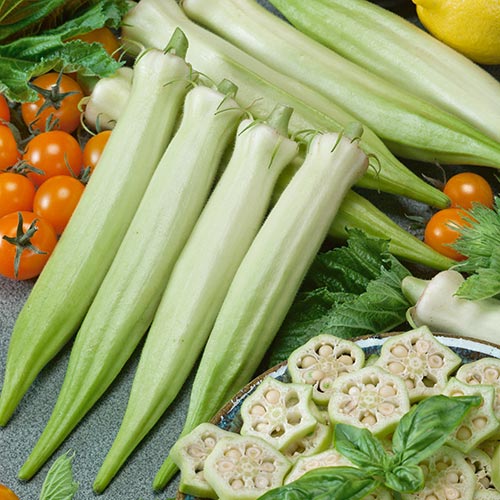
While I do enjoy a structured, planned out garden – with perennial beds here, and neat rows of vegetables over there – sometimes I long for the randomized beauty of a cottage garden. I imagine roses rambling, bee balm swaying, and even vegetables mixed in with the hardy geraniums and cosmos. Many herbs and a few veggies have a growth form that lends itself well the organized chaos of a carefully planned (so as to look completely unplanned) look of a cottage garden. Okra is one of those plants.
About Okra Plants
Okra, a full-sun veggie, originally arrived in North America from Africa in the 1600s. The first cultivars were tropical plants, and okra became a staple side dish in the South, where it was also used as a thickener for stews and gumbo. Some varieties can reach up to 6 feet tall, and with their large hibiscus-like blossoms, okra can be a great addition to a garden border or bed. A few cultivars even have colored stems, such as Gurney’s Hill Country Red Okra, an heirloom vegetable with red-orange stems and green and red pods.
Types of Okra Plants
When selecting okra varieties, you have lots of options. You can choose between hybrid and open-pollinated okra plants, and okra plants that produce red or green pods. Some okra varieties are compact and suitable for container gardening, while other okra plants grow quite large. Here are some of my favorites:
- Gurney’s® Gumbo Hybrid Okra: My favorite in terms of garden performance and flavor, it’s an improvement over many older varieties. The dark green pods stay tender longer, giving you more time to harvest, and this spineless variety makes picking easy.

- Clemson Spineless 80 Okra: One of the most popular okra varieties available, the spineless plants grow up to 4 ft. tall and produce high yields of flavorful, emerald green pods.
- French Quarter Pink Okra: A great choice for containers, small gardens and the edible landscape, the compact plants grow 24-30 inches tall and produce eye-catching pink-red pods.
- Emerald Green Velvet Okra: Generations of gardeners have loved this open-pollinated, heirloom variety for its dark green, velvety pods that stay tender, even when growing up to 6-8 inches long. The plants grow 5-8 ft. tall.
- Hill Country Red Okra: Texas heirloom variety grows up to 6 ft. tall with plump, red-tinged pods that offer a rich, old-fashioned okra flavor. Its showy flowers add to its ornamental qualities.
- Jing Orange Okra: This open-pollinated, Asian heirloom okra produces plenty of 6-7 inch, red-orange pods with a delicate flavor and tender texture. The plants grow up to 6 ft. tall.
How to Plant Okra Seeds
Before planting okra, select a place in your garden or raised garden bed. If growing okra in a container, select a container or Grow Tub large enough to accommodate the plant. Keep in mind that some okra varieties grow quite large—sometimes over 6 ft. tall.
Okra requires warm temperatures, lots of sun (6 or more hours of direct sunlight daily) and slightly acidic to neutral soil pH. Mixing aged manure or compost into the soil before planting can improve the soil and drainage.
Because okra is a tender, warm season vegetable, many gardeners start okra seeds indoors about 6 weeks before transplanting them to the garden. Make sure you have all of your seed starting supplies before sowing okra seeds. To improve seed germination, soak okra seeds overnight before sowing. In warmer areas of the country, you can directly sow okra seed into the garden when the soil temperature reaches 70 degrees.
When transplanting okra seedlings to the garden, wait until four weeks after the last spring frost date for your area. Keep in mind that okra plants like air temperatures above 60 degrees F. If you are expecting a cool night after transplanting, consider covering the okra plants with a row cover.
Because okra seeds have taproots, be careful not to break the taproot when transplanting them into the garden. Space okra plants about 18-24 inches apart, with about 3-4 ft. between rows. At planting time, add an all-natural, slow-release fertilizer, like Gurney’s Vegetable Food, to the soil. After transplanting, water the okra plants. Mulching around the plants will suppress weeds, help conserve moisture in the soil, and also help maintain the soil temperature.
Often okra plants grow slowly at first, and then really shoot up and develop once the summer temperatures warm up.
How to Grow and Care for Okra
Once established, okra plants are very drought tolerant, compared to other garden vegetables. However, if you want good pod production, consider watering at least an inch per week, just like other vegetables. When removing weeds around your okra plants, remember that okra has a fragile taproot and be careful not to disturb or damage it. As summer heat rolls in and your other vegetables fade, okra will start to grow fast. Tender pods follow the gorgeous blooms, and must be picked early as they get tough and stringy if they stay on the plant too long.
Common Diseases and Pests
Okra has few disease and pest problems. If the weather is cool or the seedlings are planted in cold, wet soil, the plants could fall victim to decay, rot or fungal diseases such as verticillium and fusarium wilts. Root knot nematodes can stunt your plants’ growth. Good gardening practices, such as crop rotation and sanitation, can help control them. Aphids are the most common pest problem. Your local extension service can help with specific pest and disease problems.
Harvesting Okra
Once your okra is producing, it’s a good idea to check it every day for any pods that might be ready for harvesting. When harvesting okra, wear gloves and long sleeves, as the stiff hairs on the leaves can cause itching. Or, opt for a spineless variety such as Clemson Spineless 80 Okra. Remember, okra is a “cut and come again” vegetable, so harvest often—and share your bounty!
How to Store Okra
Unlike some vegetables, okra pods do not have a long shelf life in the refrigerator. If unwashed and dry, okra pods can be stored in your refrigerator for about four days. If you have too much for fresh use, then okra can be preserved by freezing or canning.

